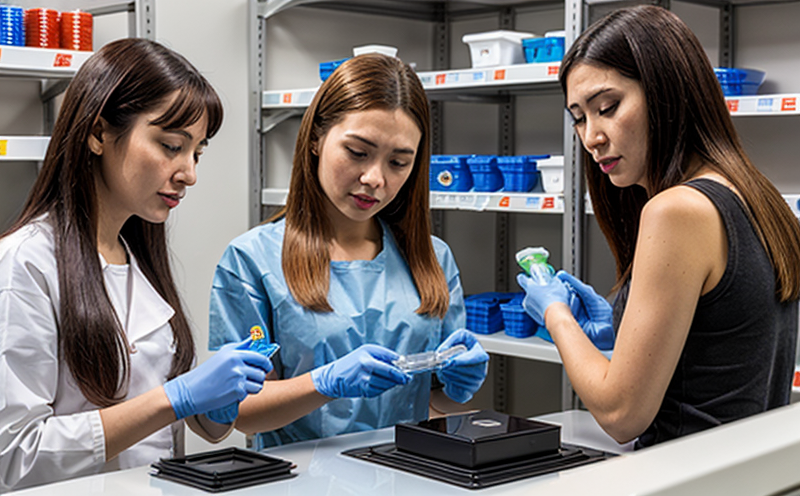SAE J200 Classification Testing of Rubber and Consumer Plastics
The SAE J200 classification testing protocol is a pivotal standard in polymer and plastics testing, particularly for rubber and consumer plastics. This test evaluates the performance characteristics that define specific classifications of materials under defined conditions. The primary objective is to ensure consistency with industry standards and regulatory requirements. Understanding this test involves examining its scope, methodology, benefits, and why it's an essential component for quality managers, compliance officers, R&D engineers, and procurement teams.
The SAE J200 classification process focuses on physical properties such as tensile strength, elongation at break, hardness, and resilience. These tests are critical in ensuring that materials meet the performance criteria set by industry standards. The test is often required to comply with international regulations, which vary across different regions.
The SAE J200 classification protocol is widely used in various sectors such as automotive, aerospace, and consumer goods manufacturing. It provides a standardized method for testing rubber and plastics to ensure that they meet the necessary performance requirements under specific conditions. This ensures consistency in product quality and reliability across different applications.
One of the key aspects of SAE J200 is its ability to classify materials based on their physical properties, which are then used to determine their suitability for particular applications. For instance, a material with high tensile strength may be suitable for automotive components that experience significant stress during operation. Similarly, a material with good elongation at break can be used in products like hoses or belts where flexibility is crucial.
The test process involves preparing specimens according to the specified dimensions and tolerances outlined in SAE J200. Specimens are then subjected to various mechanical tests using specialized equipment such as tensile testers, hardness testers, and impact testers. The results from these tests are analyzed to determine if the material meets the required classification criteria.
One of the advantages of SAE J200 is its ability to provide a standardized method for testing materials, which ensures consistency in test results across different laboratories and regions. This standardization is crucial for ensuring that products meet the necessary performance requirements under specific conditions. Additionally, the protocol allows for continuous improvement by incorporating new technologies and techniques as they become available.
The SAE J200 classification testing process provides a robust framework for evaluating rubber and consumer plastics. By following this protocol, manufacturers can ensure that their products meet the necessary performance requirements under specific conditions. This standardization is crucial for ensuring consistency in product quality and reliability across different applications. The test results are widely recognized by regulatory bodies and industry associations.
The SAE J200 classification testing process also provides a platform for continuous improvement by incorporating new technologies and techniques as they become available. For instance, the use of advanced materials such as composites or recycled plastics can be evaluated using this protocol. This ensures that manufacturers are always up-to-date with the latest developments in their industry.
In conclusion, SAE J200 classification testing is a critical tool for ensuring product quality and compliance with industry standards. By following this protocol, manufacturers can ensure that their products meet the necessary performance requirements under specific conditions. This standardization is crucial for ensuring consistency in product quality and reliability across different applications.
Scope and Methodology
- Tensile Testing: Specimens are subjected to tensile testing to determine their breaking strength and elongation at break. This test is crucial for evaluating the mechanical properties of rubber and plastics.
- Hardness Testing: Hardness tests measure the resistance of a material to indentation by a hard, sharp indenter. This test is essential for assessing the hardness of rubber and plastics.
- Impact Testing: Impact testing evaluates the ability of materials to withstand impact forces without fracturing or breaking. This test is critical for evaluating the toughness of rubber and plastics.
The SAE J200 classification testing protocol provides a standardized method for evaluating these properties, ensuring consistency in test results across different laboratories and regions. The protocol also allows for continuous improvement by incorporating new technologies and techniques as they become available.
Benefits
The SAE J200 classification testing process provides a robust framework for evaluating rubber and consumer plastics. By following this protocol, manufacturers can ensure that their products meet the necessary performance requirements under specific conditions. This standardization is crucial for ensuring consistency in product quality and reliability across different applications.
One of the key benefits of SAE J200 classification testing is its ability to provide a standardized method for evaluating materials. This ensures consistency in test results across different laboratories and regions, which is essential for regulatory compliance. Additionally, the protocol allows for continuous improvement by incorporating new technologies and techniques as they become available.
The SAE J200 classification testing process also provides a platform for continuous improvement by incorporating new technologies and techniques as they become available. For instance, the use of advanced materials such as composites or recycled plastics can be evaluated using this protocol. This ensures that manufacturers are always up-to-date with the latest developments in their industry.
Another benefit of SAE J200 classification testing is its ability to provide a standardized method for evaluating materials, which ensures consistency in test results across different laboratories and regions. The protocol also allows for continuous improvement by incorporating new technologies and techniques as they become available. This ensures that manufacturers are always up-to-date with the latest developments in their industry.





